Welcome to This Date in Aviation History, getting of you caught up on milestones, important historical events and people in aviation from July 29 through July 31.
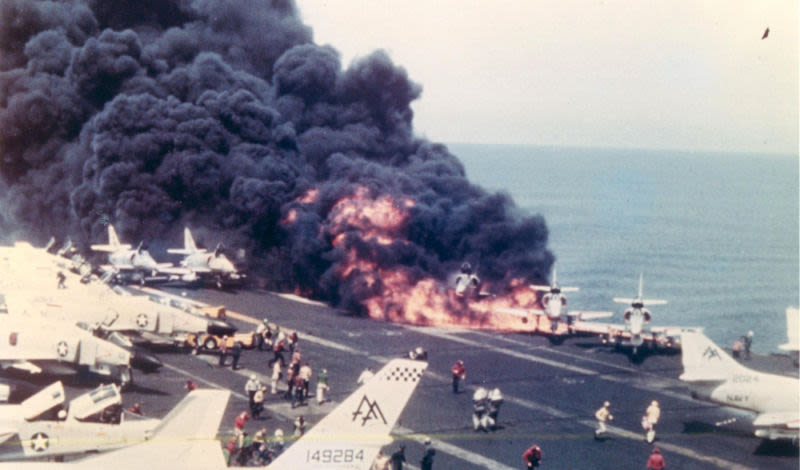
July 29, 1967 – A massive fire breaks out on the flight deck of USS Forrestal off the coast of Vietnam. Working on the flight deck of an aircraft carrier has been called one of the most dangerous jobs in the world. Controlling jet and propeller aircraft around a rolling deck is an intricate ballet of blasting jet engines and spinning propellers, with death or serious injury a constant concern. And that is just during peacetime. In wartime, the dangers are compounded by a higher tempo of operations and the presence of bombs, missiles, rockets, and fully-fueled aircraft either on the flight deck or stored belowdecks. In fact, the Battle of Midway took a critical turn when American dive bombers arrived over the Japanese fleet while aircraft were sitting on deck, fully loaded with bombs and fuel. The US Navy has been honing the art of carrier operations and carrier safety since 1920, but despite rigid safety procedures, there is always the potential for disaster.
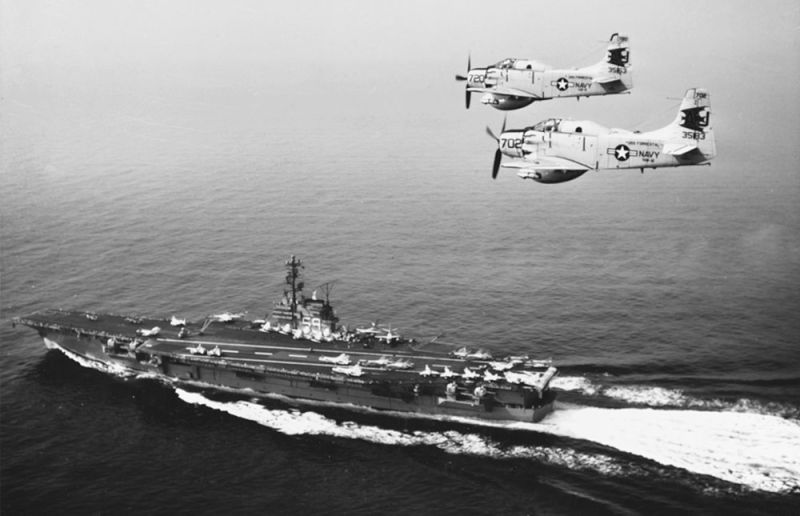
By the early summer of 1967, the war in Vietnam was escalating dramatically, and the carrier USS Forrestal (CVA-59) sailed from Norfolk, Virginia to take up a position at Yankee Station in the Gulf of Tonkin off the coast of Vietnam. Once there, Forrestal immediately began launching attacks against North Vietnam in support of American and South Vietnamese troops. But as the pace of operations increased, the Navy’s demand for bombs soon outstripped production. To keep the bombers flying, the Navy was forced to use older ordnance, some of which dated back more than 10 years and had been exposed to the elements while in storage. On the day preceding the accident, Forrestal received a shipment of 1000-pound bombs, many of which were older, unstable bombs that had been improperly stored in Guam. Forrestal’s commanding officer, Captain John Beling, at first refused the munitions, but he ended up accepting them reluctantly because of the acute shortage and the need for the bombs on sorties the following day. Forrestal’s bomb handlers were particularly concerned with the unstable bombs being stored belowdecks, where an accidental explosion could sink the entire ship. So the bombs were stored out in the open on the flight deck.
The next day, the deck of Forrestal was crowded with fueled and armed aircraft and swarmed with deck handlers, pilots, and other personnel. Shortly before 11:00 am an electrical fault in a 5-inch Zuni rocket caused it to launch uncommanded from a McDonnell Douglas F-4 Phantom parked on the flight deck. The rocket tore across the flight deck and struck the external fuel tank on an armed Douglas A-4 Skyhawk. Though the rocket did not explode, it punctured the fuel tank and the leaking fuel ignited. As damage control teams rushed to fight the rapidly spreading fire, one of the unstable bombs loaded on the Skyhawk detonated, blowing a hole in the armored flight deck and raking the deck with shrapnel. Most of the members of Forrestal’s most experienced damage control team were killed, and even more burning fuel was spread around the deck. As the fires continued to rage, nine more explosions occurred, eight of which were caused by the unstable bombs. The detonations tore holes in the flight deck that allowed burning jet fuel to flow into the living quarters below and into the interior spaces of the ship. In an effort to minimize further explosions, Forrestal’s crew pushed damaged aircraft into the water and rolled bombs overboard by hand.
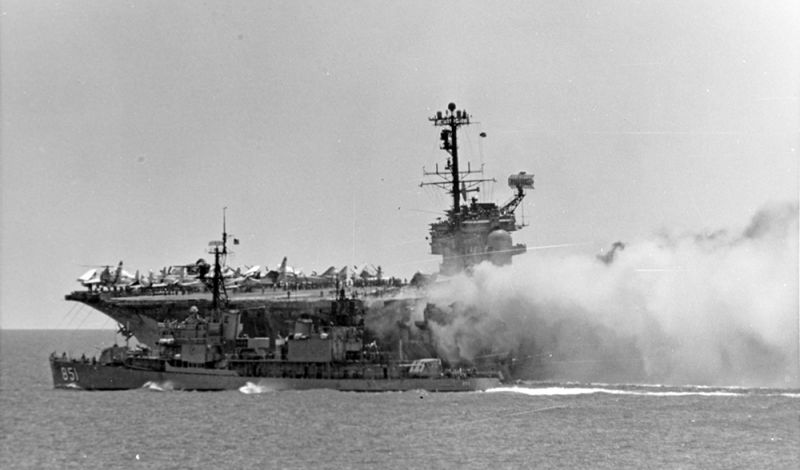
In what Rear Admiral Harvey P. Lanham later called an act of “magnificent seamanship, ” Commander Edwin Burke maneuvered the destroyer USS Rupertus (DD-851) to within 20 feet of Forrestal and held station there for 90 minutes in order to use its own fire hoses to fight the fire, and Forrestal’s crew was eventually able to extinguish the fire by 4:00 am the following morning. The fire and explosions, the worst on a US carrier since WWII, claimed the life of 134 crewmen and injured 161, many of them seriously. Forrestal returned to Norfolk, where it spent more than 200 days undergoing repairs and refitting. Though Capt. Beling was absolved of responsibility for the fire, he was assigned to staff work following the incident and retired in 1973 with the rank of Rear Admiral. Forrestal returned to service in the Mediterranean in 1968, and was decommissioned in 1993.
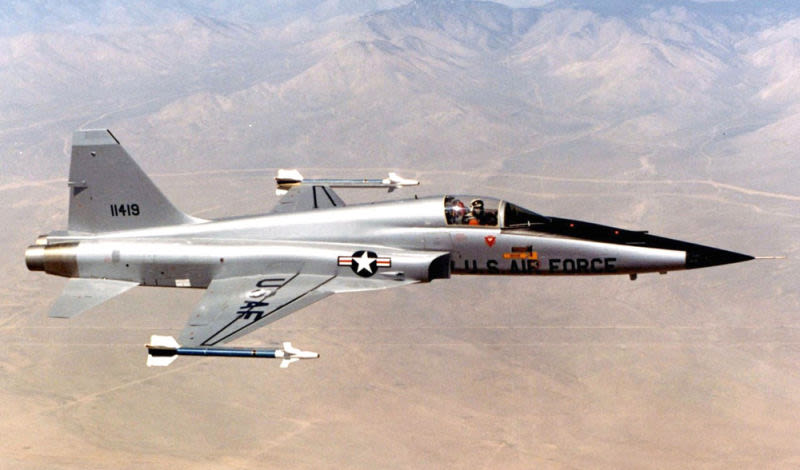
July 30, 1959 – The first flight of the Northrop F-5A Freedom Fighter. When the first jet fighters appeared near the end of WWII, they were relatively simple affairs, essentially straight-winged piston aircraft that were adapted for the new turbojet engines. But as jet engines became more powerful, fighters got bigger, more complex—and more expensive. To combat this trend, Northrop began working on a small, simple fighter in the mid-1950s called the N-156 in the hopes of securing a contract to produce a fighter that could fly from the US Navy’s smaller escort carriers. The design team was led by Northrop’s vice president of engineering Edgar Schmued, who also designed the North American P-51 Mustang and North American F-86 Sabre, arguably two of the greatest fighters ever built. Along with chief engineer Welko Gasich, the Northrop team set out with the specific goal of creating a small, low-cost fighter that would be easy to maintain and easy to fly, but would also have the potential for future growth and development.

To keep the size of their new fighter at a minimum, Northrop selected two powerful General Electric J85 turbojet engines which had originally been designed to power the McDonnell ADM-20 Quail target decoy. Though the J85 was small, weighing in at just 300-500 pounds, it provided 3,500 pounds of thrust in normal operation and 5,000 pounds with afterburner. Combined with the fighter’s small size and area rule fuselage, which gave the plucky fighter its characteristic Coke bottle shape, the F-5 was capable of a top speed of Mach 1.6 with a thrust-to-weight ratio of up to 7.5:1, compared to the McDonnell Douglas F-4 Phantom at just 4.7:1. The F-5 was armed with two 20mm M39A2 revolver cannons in the nose with 280 rounds each. Seven hardpoints could carry up to 7,000 pounds of bombs, rockets, missiles, or extra fuel tanks.
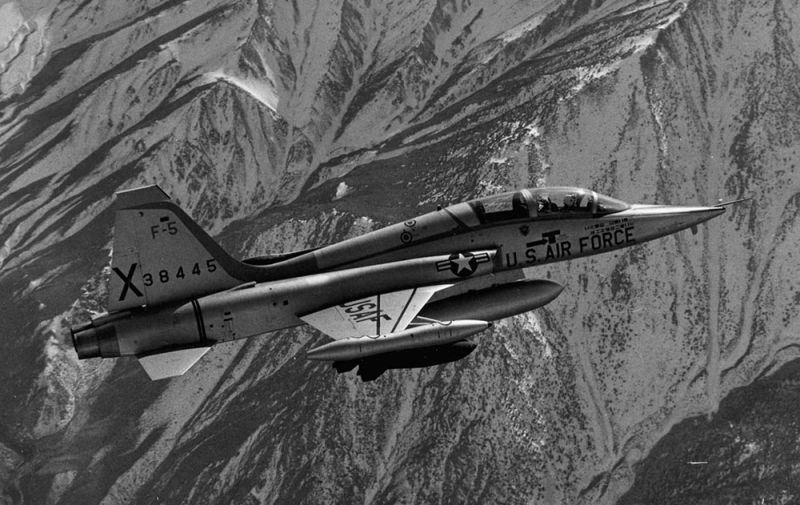
The changing needs of the US Navy led them to abandon the use of smaller escort carriers, but Northrop forged ahead with their design and developed both a single-seat fighter version, the N-156F, and a two-seat trainer version, the N-156T. In July 1956, the Air Force chose the N-156T to replace the Lockheed T-33 Shooting Star as its primary trainer, and the newly designated T-38 Talon became the first supersonic trainer and eventually the most-produced trainer in the world. Northrop continued developing the N-156F in the hopes of providing a fighter for the Military Assistance Program, which sought to arm nations allied to the US with low-cost weapons. It was this aircraft which took its maiden flight on July 30, breaking the sound barrier on its first flight.
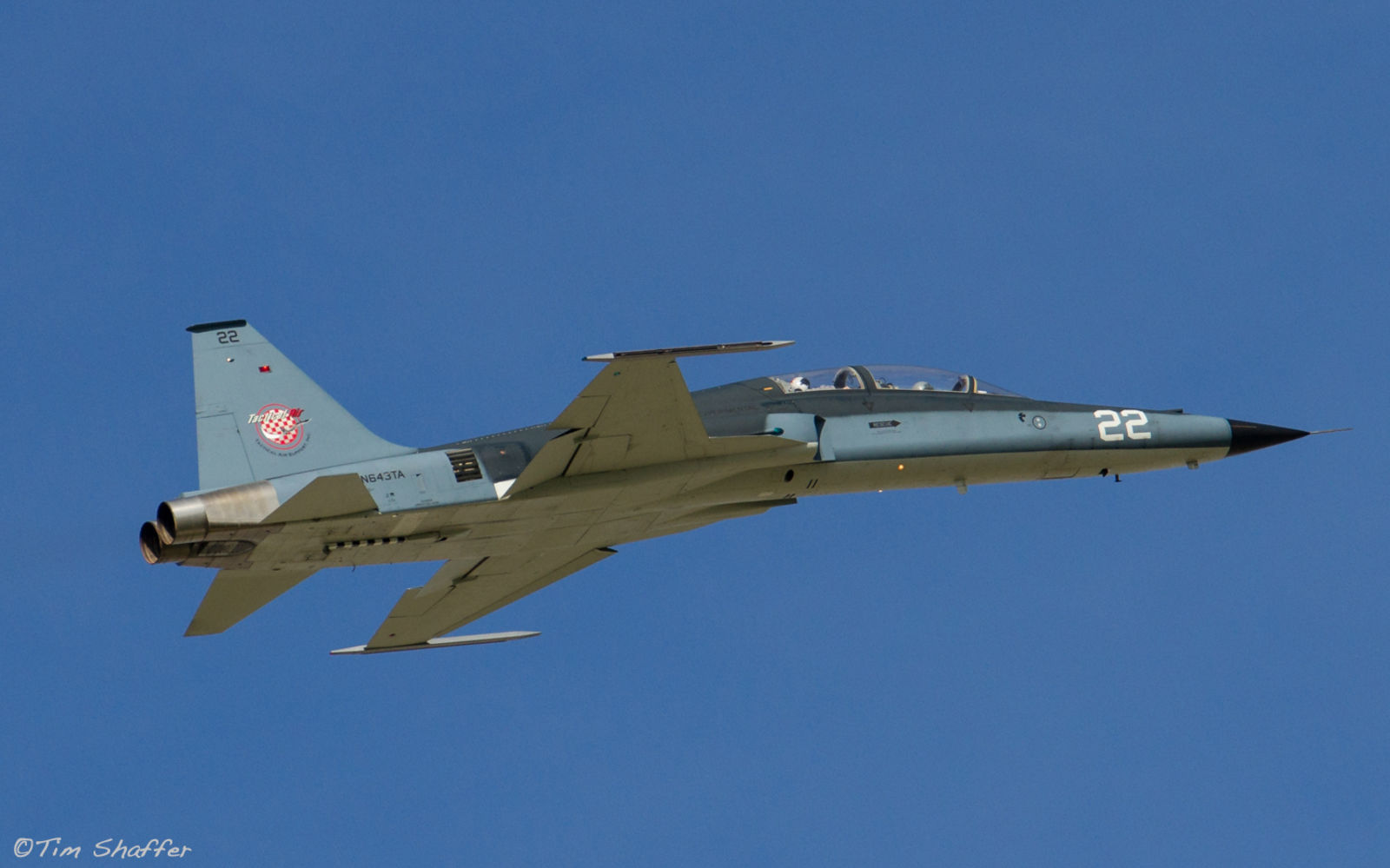
Despite the excellent performance and reliability of the F-5, the Air Force showed little interest in the fighter, and the program teetered on the edge of cancelation. However, the Kennedy Administration chose the F-5 in 1962 as the winner of the F-X completion to provide a low-cost export fighter to America’s allies. In 1965, the Air Force sent 12 F-5As to Vietnam to evaluate them under the codename Project Skoshi Tiger, and it was here that the F-5 received its unofficial nickname, which later became official with the F-5E/F Tiger II. While the F-5A and F-5E/F weren’t adopted in large numbers by the US, it continues to be flown in the aggressor role for dissimilar combat training. The Tiger II, which won the International Fighter Aircraft competition in 1970, remains in service alongside older Freedom Fighters the world over. Northrop attempted yet another upgrade to the plucky little fighter with the F-20 Tigershark, hoping to develop an export fighter that would compete with the General Dynamics F-16 Fighting Falcon, but it was ultimately unsuccessful. By the end of production in 1987, a total of 847 F-5A/B/C aircraft had been built, along with nearly 1,400 F-5E/Fs.
Short Takeoff
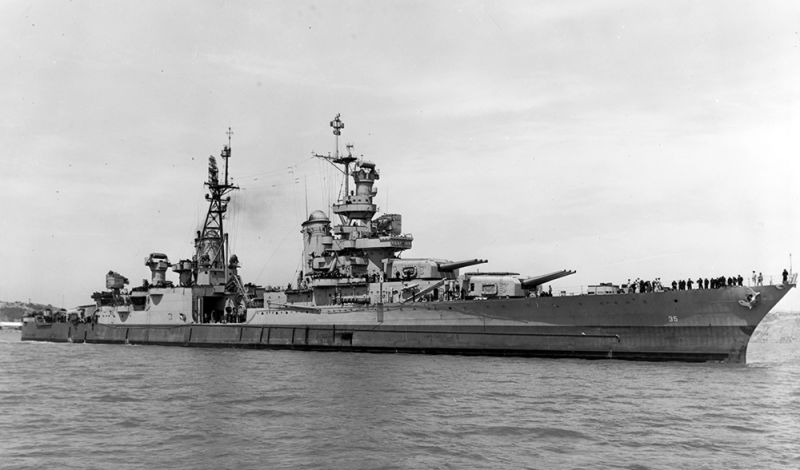
July 29, 1945 – Japanese submarine I-58 sinks the USS Indianapolis. In the lead up to the nuclear attacks on Japan that hastened the end of WWII, the heavy cruiser USS Indianapolis (CA-35) sailed to the American air base on the island of Tinian to deliver the highly-enriched uranium-235 that would be used in the Little Boy atomic bomb. After delivering its cargo, Indianapolis left Tinian bound for the Philippines, but was discovered en route by Japanese submarine I-58, which put two torpedoes into the cruiser. The ship sank in just 12 minutes. Of the nearly 1,200 man crew, roughly 300 went down with the ship, while 900 men went into the water with few life rafts, few flotation vests, and no food or water. Due to the secrecy of the mission, the Navy was unaware of the sinking, and the remainder of the crew drifted for nearly four days. The men suffered dehydration, starvation, hyper- and hypothermia, salt poisoning, skin loss, and horrifying shark attacks before they were spotted by a routine aerial patrol. A Navy PBY Catalina arrived on scene, but could only put 56 survivors on board. Many more were lashed to the wings of the plane with parachute lines until rescue ships could arrive. Of the 900 crewmen who went into the water, only 300 survived, the largest single loss of life from a single ship at sea in Navy history. Captain Charles B. McVay III was court-martialed over the sinking and found guilty of failing to zigzag, though doing so was at his discretion and he was not told that a Japanese sub was operating in the area. He was later exonerated and retired at the rank of rear admiral, but committed suicide in 1968 at age 70.

July 29, 1958 – President Dwight Eisenhower signs the National Aeronautics and Space Act, creating NASA. NASA has its origin in the National Advisory Committee for Aeronautics, an agency created in 1915 to further the efforts of aeronautic research and technological development in the United States. But as America entered the space age following WWII, the country needed an organization for a new era. The National Aeronautics and Space Act carries this simple preamble: To provide for research into problems of flight within and outside the earth’s atmosphere, and for other purposes. While NASA has done, and continues to do, research that carries military implications, its stated purpose is that of a peaceful, non-military organization. The Act goes on to say that, “The Congress hereby declares that it is the policy of the United States that activities in space should be devoted to peaceful purposes for the benefit of all mankind.” In addition to NASA’s high profile space programs such as Mercury, Gemini, Apollo, the Space Shuttle, and the International Space Station, the organization continues to fund research into all aspects of space exploration, space travel, aviation, and related sciences. NASA’s latest large project, the Space Launch System and the Orion Multi-Purpose Crew Vehicle, will see astronauts return to the Moon, create a permanent lunar station, and one day journey to Mars.
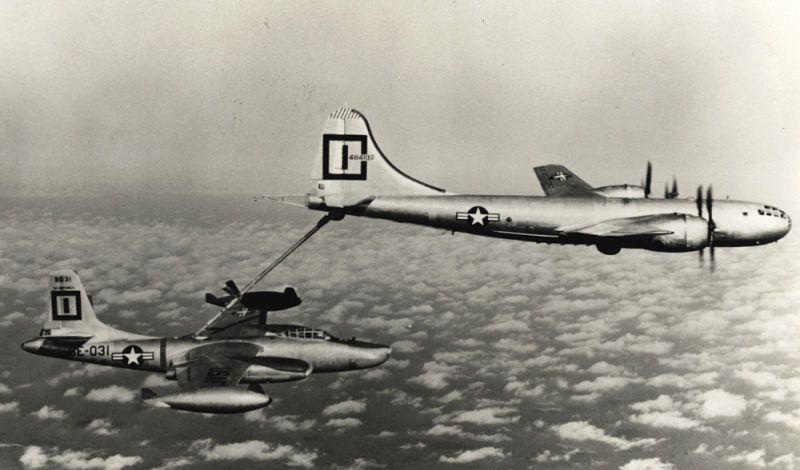
July 29, 1952 – A US Air Force North American RB-45 Tornado completes the first non-stop jet-powered flight across the Pacific Ocean. The B-45 has the distinction of being the first jet-powered bomber to enter US Air Force service, and though it was quickly superseded by the Boeing B-47 Stratojet, the RB-45 reconnaissance variant served until 1959 and made flights over the Soviet Union. To demonstrate the capability of the bomber, a B-45 of the 91st Reconnaissance Wing commanded by Maj. Lou Carrington departed from Alaska and arrived in Japan 9 hours and 50 minutes later, refueling twice in the air along the way. The midair refueling by Air Force KB-29 tankers also marked the first time a multiengine jet bomber was refueled in flight. Carrington and his crew were awarded the MacKay Trophy by the Air Force in recognition of the “most meritorious flight of the year.”
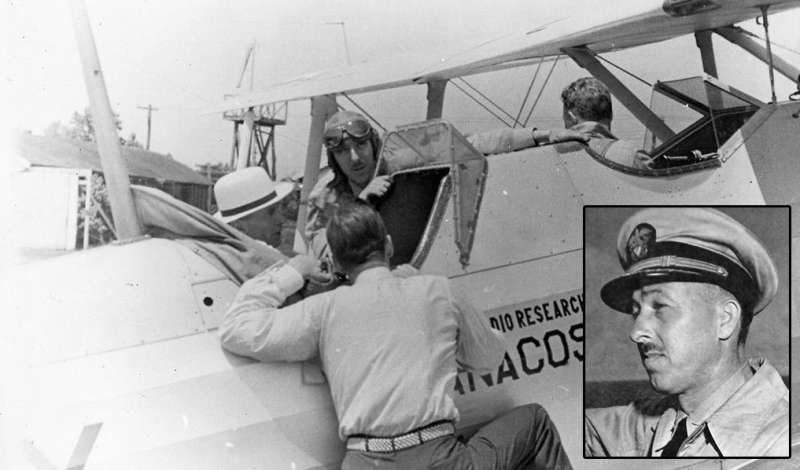
July 30, 1935 – US Navy pilot Frank Akers becomes the first person to perform a blind landing on an aircraft carrier. The importance of being able to fly without any outside visual cues was emphasized early on by American pilot Jimmy Doolittle, who, in 1929, became the first aviator to take off, fly, and land using only the airplane’s instruments. However, landing on a large airfield is not the same as landing on a small aircraft carrier. Frank Akers became a Naval Aviator in 1925, and by 1933 he was serving as a Radio Flight Test Officer and as Project Officer for Instrument Flying Development at the Naval Air Station, Anacostia, where he began working on the problem of landing on a carrier using only instruments. Akers took off from San Diego flying in the rear seat of a Berliner-Joyce OJ-2 with a hood over the cockpit. After a flight of 150 miles, Akers located and landed aboard the USS Langley, a feat which earned him the Distinguished Flying Cross. Akers was also present on board USS Hornet for the Doolittle Raid, took part in the Battle of Midway, and commanded the USS Saratoga from 1945-1946, and oversaw a record 642 landings in a single day
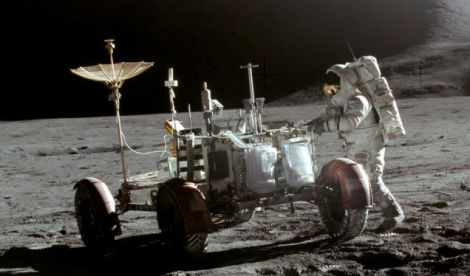
July 30, 1971 – The Apollo 15 mission deploys the first Lunar Rover on the Moon. Apollo 15 was the ninth manned mission launched by NASA as part of the Apollo program, and the fourth to land on the Moon. It was also the first of the so-called J missions which featured extended stays of more than three days on the lunar surface and a greater emphasis on scientific exploration. In order to cover more ground than was possible on foot, Apollo 15 deployed the first Lunar Roving Vehicle (LRV), a battery-powered rover that could carry two astronauts at speeds of up to eight miles per hour. Over the course of their stay on the Moon, astronauts David Scott and James Irwin covered a total distance of 17.25 miles in the Rover. The Rover, along with ones deployed by Apollo 16 and Apollo 17, remain on the Moon.
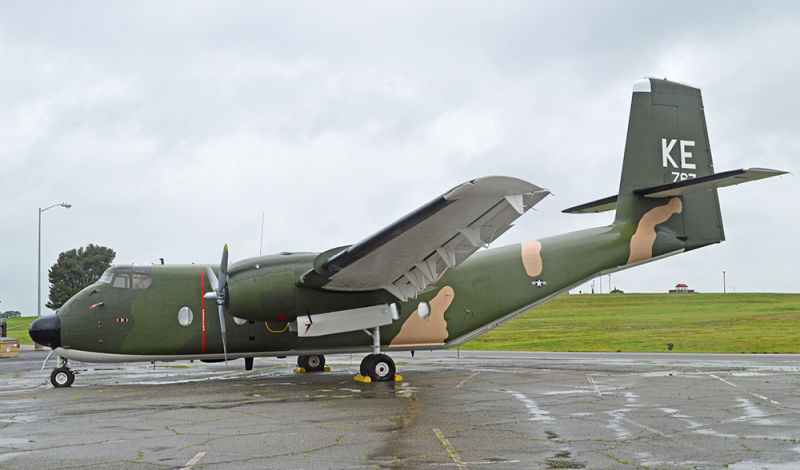
July 30, 1958 – The first flight of the de Havilland Canada DHC-4 Caribou, a cargo aircraft designed for short takeoff and landing (STOL) to fulfill a requirement from the US Army for a tactical airlifter to supply frontline troops. Following the DHC Beaver and DHC Otter, the Caribou was the first aircraft designed by de Havilland Canada to have two engines, and it entered US Army service in 1961 where it was known as the C-7. Initially seeing service in Vietnam, the Caribou’s ability to operate from runways as short as 1,200 feet made it an ideal complement to the Air Force’s larger cargo airplanes. A total of 307 were produced, and the final Caribous were retired from military service by the Royal Australian Air Force in 2009.

July 30, 1954 – The first flight of the Grumman F-11 Tiger, a day fighter developed by Grumman for the US Navy that began as an advanced development of the Grumman F-9 Cougar. Grumman eliminated the wing root air intakes and moved them forward to help reduce drag, made the wing thinner, moved the elevator down to the fuselage, and reshaped the fuselage to take advantage of the newly discovered principle of area rule. The Tiger remained a work in progress throughout its career, and also earned the dubious distinction of being the first jet to shoot itself down when it overtook its own bullets in a dive during weapons testing. The Tiger’s operational career was relatively short, though it gained notoriety when the fighter was selected by the Navy’s Blue Angels in 1957. A total of 200 Tigers were produced from 1954-1959, and it was retired from active service in 1961, though it served the Blue Angels until 1969.
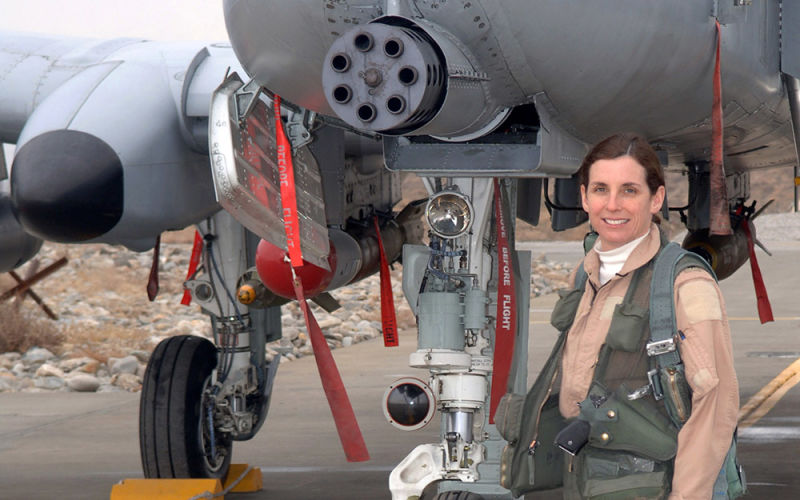
July 31, 1991 – The US Senate votes to allow women to fly combat aircraft. Women were first allowed to fly US military aircraft in WWII as members of the Women Airforce Service Pilots (WASP), but they were limited to ferrying flights and were considered civilian pilots, receiving no military benefits. The US Navy was the first branch to accept women as pilots in 1974, while the US Air Force accepted its first group of women pilots in 1976. However, women were still excluded from combat missions, even though they were flying cargo and liaison aircraft into war zones such as Panama, Grenada, and the Persian Gulf. Following the Senate vote, Martha McSally became the first American woman to fly a combat mission when she piloted a Fairchild Republic A-1o Thunderbolt II in support of Operation Southern Watch over Iraq in 1995. Today, women make up about seven percent of US Air Force combat pilots.
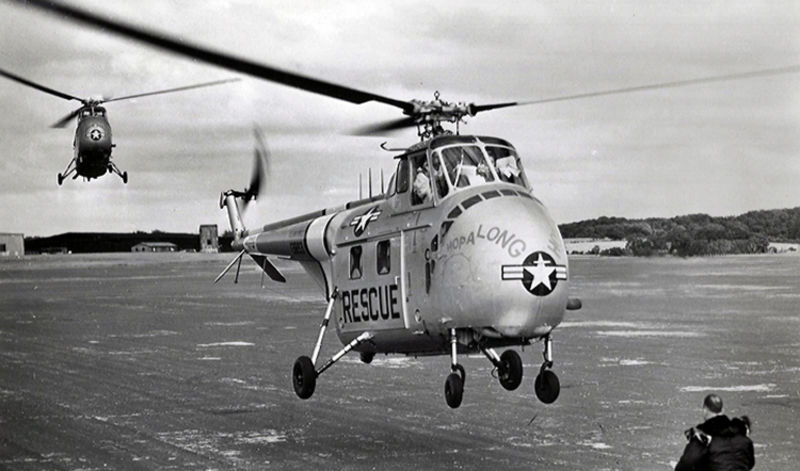
July 31, 1952 – The first transatlantic helicopter flight. For a ferry flight from the United States to Germany, two Sikorsky H-19A Chickasaws, christened Hop-A-Long and Whirl-O-Way, and modified to carry a 300-gallon fuel tank in the cabin, took off from Westover Air Force Base in Massachusetts on July 15 headed for Goose Bay, Labrador, with a stop in Maine. Accompanied by escort aircraft, the helicopters made stops in Greenland, Iceland, and finally arrived at Prestwick, Scotland on July 31. By the time the Chickasaws reached Wiesbaden, Germany, the trip had taken 21 days, due in large part to poor weather in the North Atlantic, and included nearly 52 hours of flight time. The first nonstop crossing of the Atlantic by helicopter was completed in 1967 by a pair of Sikorsky HH-3Es with nine in-flight refuelings along the way.
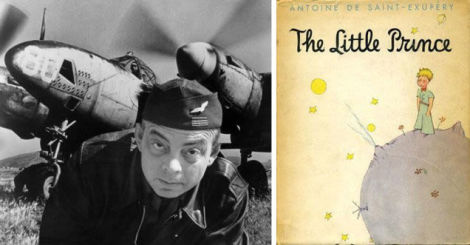
July 31, 1944 – The disappearance of Antoine de Saint-Exupéry. Born on June 29, 1900, Saint-Exupéry was a French author and pilot who is best known for his book Le Petit Prince (The Little Prince). Saint-Exupéry flew for the French Air Force in the early part WWII, then traveled to America following the fall of France to encourage the US to join the war. He later joined the Free French Air Forces in North Africa, even though his health was failing and he was beyond the age limit for service. While flying a Lockheed F-5B, the unarmed reconnaissance variant of the Lockheed P-38 Lightning, Saint-Exupéry disappeared over the Mediterranean Sea. Though remains of a pilot were found, they were not confirmed to be his, and the details of his disappearance were never determined.
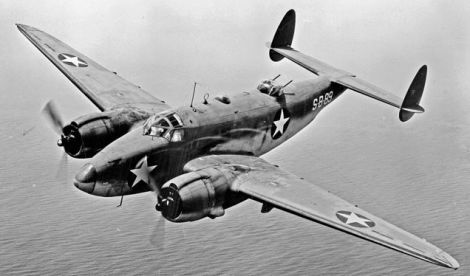
July 31, 1941 – The first flight of the Lockheed Ventura, a medium bomber and maritime patrol aircraft developed from the Lockheed Model 18 Lodestar and designed to replace the Lockheed Hudson. The Ventura was initially flown by the RAF as a medium bomber, but it suffered high combat losses and was pulled from service in favor of the de Havilland Mosquito. Remaining Venturas were moved to maritime patrol missions. In US Army Air Corps service, it was known as the B-34 Lexington and was used primarily for training, though Army Venturas were subsequently transferred to the US Navy where they gained the designation PV-1 and served primarily in the Aleutian Islands of Alaska.
Connecting Flights
If you enjoy these Aviation History posts, please let me know in the comments. You can find more posts about aviation history, aviators, and aviation oddities at Wingspan.